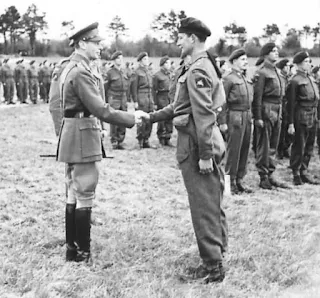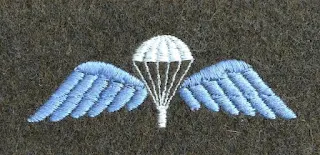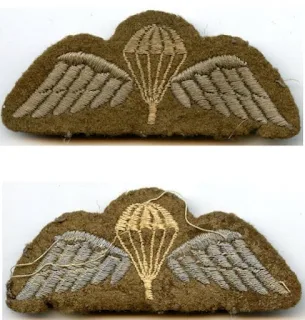Tcrown, a member of the British & Commonwealth Military Badge Forum, recently has provided his research on the origin and evolution of British Airborne Forces insignia, in the 1941 -1945 time period. He has encouraged conveying the information to collectors, historians, and all interested parties, with acknowledgement. In addition this blog author thought the information, augmented with added colored imagery of the insignia was worthy of republication. With full acknowledgement and gratitude to Tcrown. To the best of my knowledge all of the images presented herein are genuine and are discussed in detail in various other blog articles previously presented.
A Story of the British Parachute Distinguished Insignia
A few years back, I planned a bit of research on the various patches worn by the parachute battalions during WW2 https://www.britishbadgeforum.com/fo...3&postcount=17
This first post will cover the 1940 to 1942 period up until the creation of the Parachute Regiment.
1- Initial Regulations in the British Army
ACI 419 issued in May 1940 stated that Divisional Signs or badges will not be worn by British divisions during the war. This coincided with the introduction of Battle-Dress which was to provide an utilitarian uniform with no particular means to identify arms of service.
General Gort, Commander in Chief of the British Expeditionary Force at the time disapproved the decision and objected that Esprit de Corps, particularly in the Infantry would suffer if soldiers in Battle-Dress were not allowed to wear an emblem showing the regiment to which they belong.
ACI 1118 published on 18 September 1940 finally approved certain distinguished marks. For the early parachute troops, this translated into the introduction and approval of a special badge for wear by qualified parachutists through ACI 1589 dated 28 December 1940. As for Regimental flashes or other formation signs, there were none for the only parachute unit at the time – the 11th SAS.
 |
| Members of the 11st SAS photographed in Feb 1941 (source IWM)[/SIZE] |
2- Introduction of Additional Formation Badges
ACI 2587 dated 27 December 1941 set out formation patches as well as arm-of-service strips, rank badge backing and regimental badges to be worn at the top of both sleeves of the Battle-Dress blouse.
The Army Air Corps had just been formed on 21 Dec 1941 with the intend of overseeing all airborne forces that were under (glider, parachute and air landing activities).
Around the end of 1941, a group of airborne officers led by Gen “Boy” Browning formed the “Dungeon Party”, so named as they were located in the basement of GHQ Home Forces in Storeys Gate London, to create British airborne forces. Gen Browning was acutely aware that the then fledgling airborne forces needed a powerful, unifying symbol, taking advantage of the fact that formation patches had just been authorized to be worn on Battle-Dress. The myth of Bellerophon astride Pegasus was chosen as the symbol of airborne forces. The design of the now famous Pegasus flash was commissioned by General Browning to Major Edward Seago, a reputable artist.
 |
| The “Dungeon Party” ca mid 1942. Lt Col JA Goshen can be seen on the far right front row. He was the G4 logistics staff officer under Gen Browning (source ParaData) |
An interesting photo taken immediately after the return of the raid party to Bruneval aboard Prins Albert, shows that both printed Pegasus and Airborne strip had already started to be issued in early 1942.
 |
| Lt Col John Goshen, G4 of Airborne Forces Staff, with Major Frost aboard Prins Albert in Portsmouth on Feb 28th 1942 (source IWM) |
The situation was much different for the glider or airlanding troops as they had been transferred or converted into airborne forces by formed regiments with their own designation. They already had their shoulder titles, although unofficial. So, for these airborne troops who were not parachutists, the Airborne strip was introduced in early 1942 which was to be worn below the Pegasus patches. The Airborne strip would later be officially authorized by ACI 2816 on 31 Oct 1942.
 |
| Printed Airborne shoulder titles issued to Parachute forces and to Glider pilots in 1942 (source IWM) |
It seems that Airborne shoulder titles had been issued at the same period to qualified and active parachutists as we can see in the following photographs. ACI 2587 of 27 Dec 1941 didn’t authorize regimental designations except for the Household Cavalry and the Foot Guards. The designation ‘Airborne’ was added to the exceptions for the members of the Airborne troops.
 |
Inspection by HM the King of 3rd Parachute Battalion on Mar 25, 1942 (source IWM) |
 |
| Inspection by HM the King of members of the 5th (Scottish) Parachute Battalion at the time in formation, with Brigadier Flavel and Maj Gen Browning on May 21, 1942 at Bulford (source IWM) |
4 – The Creation of the Parachute Regiment
Special Army order 128 dated on 31 August 1942 detailed the formation of the Glider Pilot Regiment with effect from 24th Feb 1942 and the Parachute Regiment with effect from 1st Aug 1942. With a Regimental designation, unofficial shoulder titles would start replacing gradually the ‘Airborne’ titles with ‘Parachute’ titles.
 |
| Unissued grouping from Pte Charles Myatt who joined 1 Bat T Coy in Aug/Sept 1942. Note the non conforming private purchase Pegasus patch as well as standard trimmed Para wings (source Paradata) |
Many members of the Parachute forces continued to wear the Airborne shoulder titles and the conversion to ‘Parachute’ shoulder titles remained somewhat limited in 1942. The 1st Parachute Brigade was soon deployed to North Africa in November and at the time the wearing of distinctive formation badges on Battle-Dress was strictly prohibited while in campaign overseas.
 |
| Lt Col JD Frost receiving DSO from General Anderso on 15 Jan 1943 near Souk el Khemis (source IWM) |
 |
| Members of 1st Para Brigade at Algiers Nov 1942 showing no distinctive insignias as per regulations (Source IWM NA87) |
2nd Brigade which was still in formation in the UK in early 1943 was inspected by HM the King on April 2 in Bulford, just before being deployed to North Africa later in the month.
All members of the three battalions were wearing the ‘Airborne’ shoulder titles as evidenced in the following photos.
 |
| 4th Para Battalion inspected on 2 Apr 1943 by HM the Kingalong with Lt Col Dene & Brigadier Down (source IWM H28678). Note the blackened webbing, something specific to the 4th Battalion. |
 |
| 5th (Scottish) Para Battalion inspected on 2 Apr 1943 by HM the King along with Brigadiers Down & Hotchinson (source IWM H28674) |
 |
| Lt Col Pritchard presenting 6th (Welsh) Para Bat to HM the King on 2 Apr 1943 (source IWM H28681) |
With ACI 905 dated 12 June 1943, the text of Regimental designations was officially approved, and shoulder titles would be formally authorized. The text ’Parachute Regiment’ became the official designation of the Regiment. The Army instruction also defined the colours of background and lettering of the Regimental shoulder titles as respectively Cambridge blue and dark blue, colours that would be common for all formations belonging to the Army Air Corps.
The new blue ‘Parachute Regiment’ titles were issued to the Brigades that were in the UK about to form the 6th Airborne division (3rd and 5th Brigades).
Most of the members of both Para Brigades in the 6th Airborne Division not only worn the blue Parachute shoulder titles but also the Airborne strips which became no longer a unique attribute of non parachutists within Airborne forces.
 |
| A group of soldiers from the 7th Parachute Battalion ca 1944 (source Para Data) |
Some of the few who adopted the unofficial Parachute title in late 1942/early 1943 converted to the official Parachute Regiment titles and Airborne strips as we can see below:
 |
| Lt Col Pine-Coffin on 2 Oct 1942 shortly after being appointed CO of 3rd Battalion (source IWM) |
 |
| Lt Col Pine-Coffin on 19 May 1944, inspecting 7th Battalion as CO (source IWM H38604) |


















.jpg)
.jpg)


No comments:
Post a Comment